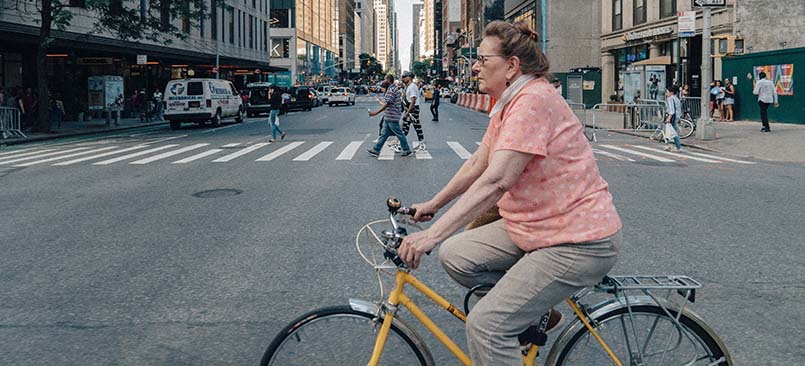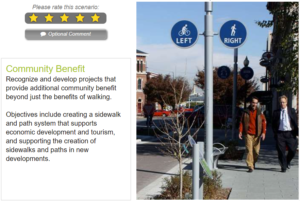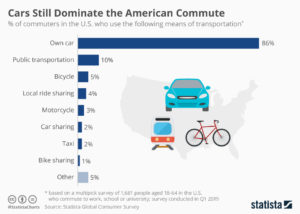Gauging Community Interest in Active Transportation

What is active transportation?
Active transportation (AT) can be described as any type of transportation where one’s own power is used to move from place to place. Most often, it is used to refer to walking or biking/cycling. Although there is a lot of research describing AT’s many benefits, transportation planning agencies still need a good understanding of community interest to support potential AT plans. Particularly in the post-pandemic era, patterns of transportation behavior have changed, and active transportation is expected to play a bigger role in coming years.
Before we take a deeper look into how agencies can gauge community interest in active transportation, let’s review the many benefits of AT.
Benefits of Active Transportation
There are numerous benefits on many levels attributed to active transportation, including: individual health, social health and cohesion, and support for the transportation system, environment, and economy.
AT activities such as walking or biking contribute positively to individual human health; physical activity reduces the risk of obesity, diabetes, heart disease, and stroke, among other chronic health conditions. This not only benefits the health of the individual but the entire public health system at large.
Further, it tends to increase social exchanges, helping to develop social cohesion, and is widely accessible as there are few costs associated with AT activities, and little or no equipment needed. It also reduces congestion, benefiting the transportation system as well as the environment due to lower greenhouse gas emissions; is emission-free itself, and helps individuals save money on insurance, gas and parking as well as other costs associated with driving single occupancy vehicles.
Overall, the benefits of active transportation are far-ranging and go beyond the individuals engaging in walking, bike, and other activities, and has positive repercussions for infrastructure and overall social health.
Gauging Community Interest in Active Transportation
People’s interest in active transportation depends on a number of factors. Certainly, comfort levels, personal preference and existing infrastructure play a role. Over the course of the COVID-19 pandemic, many urban areas transformed roads into pedestrian friendly areas, and the trends of transportation preferences are shifting as a result of remote-working and stay-at-home orders. To understand motivations and limitations, many agencies use tools like MetroQuest to create engaging and educating surveys to collect public input.
For example, Indianapolis MPO has created several surveys around active transportation. A notable example is the Regional Bikeways plan, which updated a plan from 2015 with a proposed additional 2000+ miles of bikeways. The plan is a resource for communities as well as a potential tool for federal funding. The survey was designed to understand preferences for bike infrastructure funding in Central Indiana by receiving data-driven project prioritizations based on public input and identify locations for improved connectivity. Ultimately, this survey received over 1500+ participants!
The team behind the survey discusses some of their active transportation plans and studies at length in this webinar on Indianapolis MPO’s formula for actionable public input.
Infrastructure and Active Transportation
There are correlations between the built environment and higher levels of active transportation. Mixed land-use leading to more accessible amenities and services, shorter distances between origin and destination, as well as the presence of infrastructure such as sidewalks, crosswalks, or bike lanes all correlate to higher active transportation levels in the community.
The lack of the same infrastructure creates barriers. Particularly, the lack of sidewalks, crosswalks or dedicated bike lanes is a major deterrent as people fear for their safety. The role of active transportation infrastructure is well studied. Documents show that dedicated bike lanes or boulevards or other paths separate from roads are correlated with increased levels of biking. In addition, other factors include intersection density, traffic calming features, and population density. In another of Indianapolis MPO’s active transportation surveys, the team found that lack of amenities, unsafe intersections or crossings, traffic conditions, and perceived crash risk, along with poor health were also cited as barriers.

Indianapolis MPO asked community members to rank pedestrian plan goals, such as community benefits, quality of life, and safety
To try out the agency’s survey for yourself, take a look at this demo. This version does not collect data.
Active transportation has benefits for individuals as well as communities, from personal health, to increased social exchanges, to benefits on a wider scale. As transportation patterns shift, methods and tools that support a better understanding of community interest in alternative transportation, transit, or pedestrian/biking infrastructure, will support agencies in building communities that meets the needs of their people.
What do you think is the future of active transportation? Let us know in the comments!
